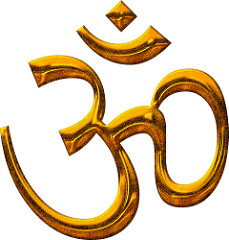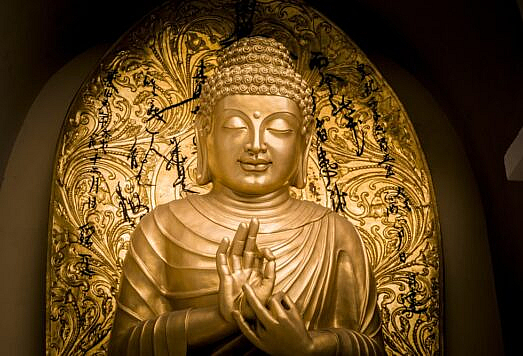Vedanta is known as Uttara-mĩmāmsā, which developed from the Upanishads and is the culmination of Vedic thought. In fact, Vedanta literally means end of the Veda’s or conclusion of the Veda’s. In ancient times, an Indian student’s education was not considered complete until he/she received instructions in the Upanishads, but it is said that mere study of the Veda’s is not sufficient to enable one to reach his/her goal. Rather, one needs to realise its teachings experientially.
Upanishads are written in symbolic language and it is not possible to unravel their terse metaphorical teachings without the guidance of an accomplished teacher. The meaning of Upanishad is a scripture that can only be studied and properly understood while sitting close to the teacher.
All schools of Vedanta try to resolve the following major questions:
What is the ultimate reality?
From where do all physical and mental phenomena originate?
What is the nature of the state in which all phenomena dissolve?
What is that reality through which everything is known?
What is that which makes an unknown known?
What is the means for attaining immortality?
What is the Nature of the Self?
What happens after death?
What is the importance of the body, mind and senses?
All the Upanishads share a common understanding regarding these questions and their resolutions.
An example is that the Upanishads unanimously maintain the existence of an all-pervasive Reality, called Brahman or Atman.
The Concept of Atman, the Self
According to Sankara, considered the founder of Advaita (monistic, non-dualistic) Vedanta philosophy, Self is the all-pervading, self-illuminated Consciousness. It is the highest truth, the absolute. It is beyond all phenomena in existence, beyond time, space, and causation, and it cannot be experienced by the senses or the mind. That is called Atman, the Self.
The Self is considered as distinguished from the body, breath, mind, and intellect which covers the Self like veils or sheaths (koshas). The Self is considered to be eternal and to have the essential nature of bliss and knowledge. Whatever seems to be pleasant is so because of the existence of the pure Self in that object; the pure Self is the ultimate source of all joy. The Self is to be realised with the help of a sharp and penetrating intellect. Self-realisation is the highest goal of life. To achieve this goal, the Upanishads do not encourage external rituals but instead emphasise the internalisation of awareness.
Pure Self is beyond decay and death. The source of Consciousness, the Self, is always the same, unchangeable and immortal. It flows from eternity to eternity and from infinity to infinity. It is the very source of consciousness; it provides vitality and energy for the functions of all energies, senses, mind, and intellect. Atman is the inherent essence of all beings; it is eternal, beginningless, and endless. Perfection is its vital stuff, but lack of insight prevents a person from seeing the truth of his immortal nature. The Bhagavad Gita says that the Self cannot be born and cannot be killed. Indestructibility is the essential nature of the Self.
The Concept of Brahman, the Supreme Consciousness
According to Sankara, Brahman is the ultimate truth within and without. Brahman is all-pervading and self-illumined Consciousness. There is only one reality and that is Brahman; Brahman and Atman are identical. Brahman is the very source of existence from which springs the entire universe qualified by name and form. Brahman is the resplendent, unaffected, and unchanged Absolute. Nothing exists separately from Brahman. One can perceive things separated from Brahman, but this is cosmic illusion (Maya), which makes Sankara’s theory unique. Vedanta actually does not recognise the concept of bondage or liberation because the soul (Atman) and Supreme Consciousness (Brahman) are one and the same and remain always unaffected by changeability and partiality.
The Concept of Maya
Advaita Vedanta philosophers explain the existence of the universe with the help of the concept of Maya (cosmic illusion), which is found in the Upanishads. The Upanishads state that the face of Truth is veiled with the golden disc of Maya, which must be removed for one to realise the ultimate Truth. Because Maya veils the Truth, the individual self misconstrues both the world and itself as being different from Brahman.
Vedanta, the path of Knowledge
Vedanta is generally known as Jnana Yoga, the path of knowledge. People misunderstand this path and think it is the path of renunciation, but it is actually the path of conquest. The student of Vedanta renounces the world not as a failure but as a conquerer. It is practiced through two different means: contemplation and meditation. Through contemplation one comes to know and through meditation to realise. The eternal sound Ohm, which both symbolically and actually describes the actual Reality, is used as the primary object of contemplation in Vedanta. The Upanishads say Ohm is the bow, individual Self is the arrow and the Supreme Consciousness, Brahman the target.
Vedanta philosophy further elaborates on the five sheats (koshas), the universe, God, human life, the life force (prana), liberation and the goal of life, self-realisation.
Source: Pandit Rajmani Tigunait PhD, Seven systems of Indian Philosophy.
For more in-debt information on Vedanta philosophy or questions contact Vedanta Wellbeing PhD








